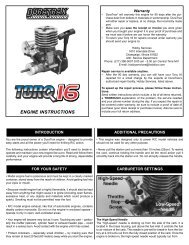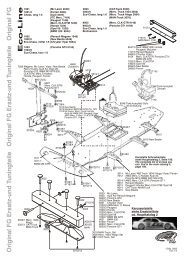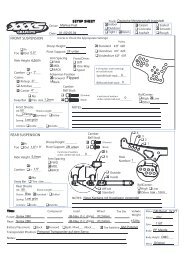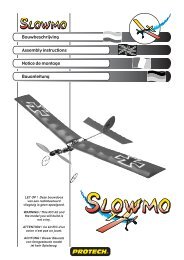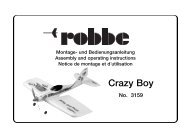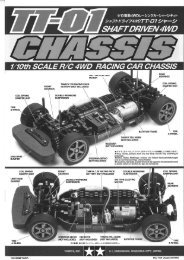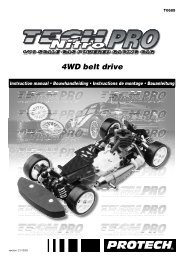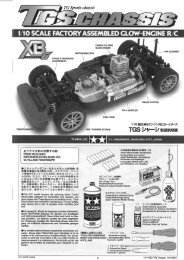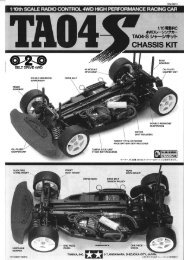Robbe Cardinal.pdf - RCtube.eu
Robbe Cardinal.pdf - RCtube.eu
Robbe Cardinal.pdf - RCtube.eu
Create successful ePaper yourself
Turn your PDF publications into a flip-book with our unique Google optimized e-Paper software.
Das Modell ist bereit zum Erstflug. Es ist einfach zu beherrschen,<br />
jedoch müssen, wie bei jedem Flugmodell einige<br />
Grundregeln beachtet werden.<br />
Man sollte sich, bevor man auf das Flugfeld geht mit dieser<br />
Fluganleitung vertraut machen. Nachfolgend wird das<br />
St<strong>eu</strong>ern erklärt, damit das Modell viel Flugvergnügen bereitet.<br />
Wetterbedingungen und Gelände<br />
Das Flugwetter<br />
Da das Modell ein langsam fliegendes Fluggerät ist, darf der<br />
Wind gewisse Stärken nicht überschreiten. Um die<br />
Windstärke b<strong>eu</strong>rteilen zu können, orientiert man sich am<br />
besten an Bäumen. Bei Bewegung der Blätter und<br />
Zweigbewegungen kann das Modell ohne weiteres geflogen<br />
werden. Bei d<strong>eu</strong>tlicher Bewegung von Ästen ist der Wind<br />
so stark, daß das Modell nicht eingesetzt werden sollte.<br />
Die Auswahl des Fluggeländes<br />
Zum Fliegen eignen sich ein leicht geneigter Hang oder eine<br />
flache, freie Wiese am besten. Die Nähe von<br />
Hochspannungsleitungen, verkehrsreichen Straßen,<br />
Ansiedlungen und Flugplätzen sowie anderen Hindernissen<br />
ist zu meiden.<br />
Ein Hang kann im wesentlichen in vier Fluggebiete<br />
unterteilt werden.<br />
- Sektor „A“: Flaches, turbulenzfreies Gelände, in dem<br />
geflogen werden kann.<br />
- Sektor „B“: Aufwindgebiet am Hang, ebenfalls zum<br />
Fliegen geeignet<br />
- Sektor „C“: An Hängen schwaches Aufwindgebiet, in<br />
welchem Höhe abgebaut werden kann und gelandet wird.<br />
- Sektor „D“: Gebiet in welchem durch Fallwind (Lee) und<br />
Turbulenzen nicht geflogen werden darf.<br />
- Hindernisse wie Bäume, Häuser, Buschreihen etc. erz<strong>eu</strong>gen<br />
auch in der Ebene Turbulenzen. Niemals hinter diesen<br />
Hindernissen fliegen, wenn der Wind über diese hinwegstreicht.<br />
Bauanleitung, Assembly instructions, Notice de montage<br />
<strong>Cardinal</strong><br />
Your model should be ready for its first flight. The model is<br />
easy to master, but it is important to observe a few basic<br />
rules, as with any model aircraft.<br />
Before you head for the flying field please read through these<br />
instructions and study them carefully. The text includes<br />
details of controlling the model, to ensure that your model<br />
gives you many hours of pleasure.<br />
Weather conditions and flying sites<br />
Weather for flying<br />
Since the model is a slow-flying machine the wind must not be<br />
too strong. The easiest way of assessing wind speed is to<br />
look at nearby trees. If leaves and twigs are moving then the<br />
model can be flown without any worries. If branches are<br />
clearly moving about then the wind is too strong, and you<br />
should not fly the model.<br />
Flying sites<br />
The ideal flying site for your model is a flat open field or a gentle<br />
slope. Keep well away from high tension overhead cables,<br />
roads carrying heavy traffic, houses and airports, and any<br />
other potential obstruction.<br />
A slope can be divided into four flying areas:<br />
- Sector "A": Flat, turbulence-free area in which flying can be<br />
carried out.<br />
- Sector "B": Lift area at the slope, also good for flying.<br />
- Sector "C": Area of weak lift on the slope, where you can<br />
lose height and land.<br />
- Sector "D": Area in which turbulence and downdraught<br />
make flying impossible.<br />
- Obstructions such as trees, houses, hedges etc. can also<br />
produce turbulence at a flat flying site. Never fly behind<br />
such obstacles when the wind is flowing over them.<br />
31<br />
No.<br />
3026<br />
Votre modèle est prêt à entamer son premier vol. Cet avion<br />
est relativement facile à piloter. Il faut toutefois, comme pour<br />
tout aéroplane, respecter un certain nombre de principes.<br />
Lisez attentivement les présentes consignes avant d’aller au<br />
terrain de vol. Des conseils de pilotage vous sont indiqués<br />
afin que le modèle vous procure beaucoup de plaisir.<br />
Conditions climatiques et géographiques<br />
Le temps<br />
Le modèle est un appareil à vol lent qui ne doit pas voler en<br />
présence de certaines forces de vent. Pour estimer la force<br />
du vent observez le f<strong>eu</strong>illage des arbres. Si le vent agite les<br />
f<strong>eu</strong>illes et les rameaux vous pouvez voler sans crainte. Par<br />
contre, si le vent agite les branches il est trop fort pour le<br />
modèle.<br />
Le choix du terrain<br />
Pour lancer le modèle il est préférable de choisir une pente à<br />
faible inclinaison ou une prairie plane sans relief. Eviter la<br />
proximité de lignes à haute tension, de routes très fréquentées,<br />
de maisons et d’aérodromes de même que de tout autre<br />
obstacle.<br />
Une pente p<strong>eu</strong>t être divisée en quatre zones de vol différentes:<br />
- Sect<strong>eu</strong>r „A“:<br />
terrain plat sans turbulence à partir duquel il est possible de<br />
voler.<br />
- Sect<strong>eu</strong>r „B“:<br />
zone de vent ascendant également propre au pilotage.<br />
- Sect<strong>eu</strong>r „C“:<br />
zone d’ascendances faibles dans laquelle il est possible de<br />
réduire l’altitude et d’atterrir.<br />
- Sect<strong>eu</strong>r „D“: zone de rabattants et de turbulences dans<br />
laquelle il n’est pas indiqué de voler.<br />
- Les obstacles comme les arbres, les maisons, les haies etc.<br />
provoquent également des turbulences en plaine. Ne<br />
jamais voler derrière ces obstacles lorsque le vent a soufflé<br />
au dessus de c<strong>eu</strong>x-ci.



